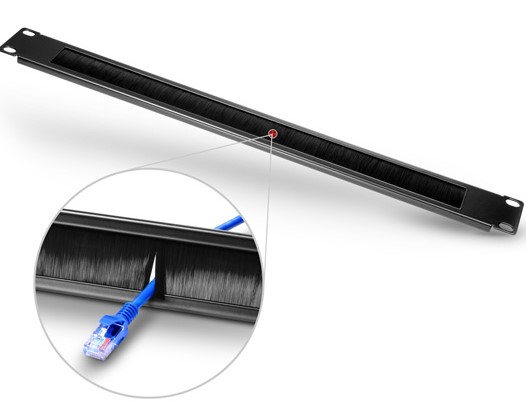Introduction
Long before the born of cable manager, the mess cable management with cables hanging here and there has been a cloud over the data centre and server room. How can you realize each smooth and convenient operation on your network application with network cables looking like messy spaghetti? Here we list four common cable managers to simplify your cabling and minimize the trouble during operation.
Different Types of Cable Manager
The following cable managers which you may have heard of or seen before are the most popular types in the market. Each has its unique design and characteristics.
The panel is designed to be mounted on any 19in EIA style rack or cabinet and features built-in brush that allows passage of up to 25 cables while blocking airflow, ensuring optimal thermal performance. The steel construction provides durability, resists corrosion, and keeps your rack looking smooth and professional.
Cable Manager with Finger Duct
The FS.COM finger duct horizontal cable manager is designed with flexible fingers, rear pass-through holes and a removable cover. The soft and durable finger ducts offer proper bend radius and flexible operation of cable management, keeping the structured cabling system unhurt and totally functional.
Cable Manager with D-rings
The name of D-rings cable manager originates from the fact that five metal D-rings stand vertically on the cable management panel in a good order. Horizontal cable management panels with D Rings are built with steel for strength and durability. Easily route large amounts of cable through robust rings. The D-Rings organize patch cords and maintain a required bend radius. They are available in sizes of 1U and 2U.
Cable Manager with Bend Radius Finger
This cable manager is equipped with six or five bend radius control fingers, consuming much fewer material. The total length of it is 222mm. Light in weight, this type of bracket can be installed in specific areas of the rack, rather than along its entire height. Moreover, it can be stacked to reach any height(U), so it can be an alternative of higher vertical cable management.
How to Apply Cable Manager
Cable managers often come together with patch panel to make the patch cables in the front side of patch panel more orderly. Generally, in a server rack, the cable can’t either be put solely on cable manager since it is incompetent for termination, or be applied to just a patch panel due to its imperfect cable management. Therefore, to realize the perfect cable management, we need to deploy this couple at the same time. The cables going out from the patch panel have already gone through the management process, but it should go to the next cable manager installed above or below the patch panel, so that the whole cable management can be finished. Additionally, some people will need the further step to bring the cables that are from horizontal cable management to the vertical cable managers standing at the both sides of the cabinet.
Conclusion
Never look down upon cable management, otherwise the cables haphazardly thrown around will be your nightmare. In case it damages the wires and cause other hazards, now it’s time to arrange your cables properly. FS.COM has many kinds of cable managers to help make your life neater!




